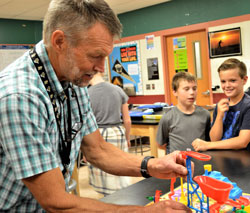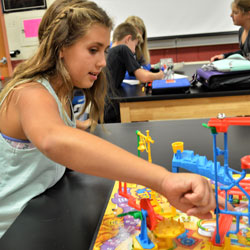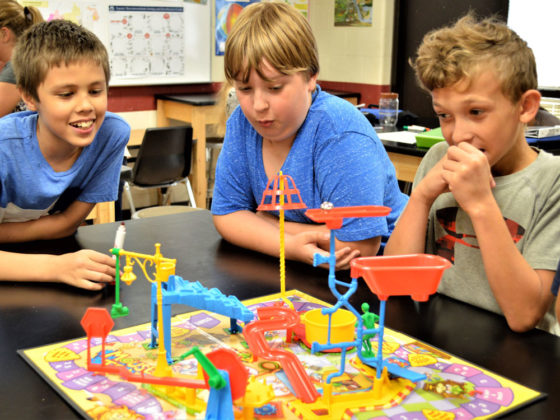Who knew that the table game Mouse Trap has seven subsystems? After a class period of exploration, sixth-graders in Greg Busse’s class not only knew about subsystems, they could identify where each started and ended in the game.
Early in the semester, students were asked to use the game, where the object is to successfully move a mouse-shaped piece along a Rube Goldberg-type path, to learn about subsystems and identify “contact points” where the mouse needs to find energy to move from one phase to the next.
Students divided into groups to identify boundaries of one of the seven sections of the path. Each section — or subsystem — was identified as the point at which the mouse found energy to connect it with the next section of the path.

By the end of the one-hour class period, each group was expected to share a diagram and explanation of their findings.
The hands-on exercise readied them for upcoming science classes, during which they were to be divided into groups and presented with a situation. Students then were expected to identify problems and find questions needing answers, apply scientific techniques to find the answers and share the results.
Busse was utilizing for the first time this school year the Mi-STAR Curriculum, designed for sixth through eighth-graders. “The idea is to have students come up with the questions and then the answers by themselves,” he said.
Busse said he worked with the Kent ISD science team to bring the relatively new standards into more classrooms. Mi-STAR is aligned with Next Generation Science Standards, a set of teaching guidelines outlined in “A Framework for K-12 Science Education.”
‘My brain works better’
“My brain works better with this method,” said sixth-grader Caleb Shick. “And it is more fun to figure it out, instead of just being told how it works.”
Another plus, said sixth-grader Oliviah Reister, is that they often worked in groups. She particularly liked the unit on food sources. “It was really interesting making food webs and finding all the information by ourselves,” she said.
Katelyn VanderWerff, also in sixth grade, pointed to the unit on cells and a project where each group used Google Maps and the village of Sparta to learn the various parts of a cell.
“It was really fun deciding on the nucleus,” she said. “We used the Sparta Township Hall as our nucleus and then found other businesses and points in Sparta around it. Every group did something a little different, and it was really fun when we shared it out.”

Classroom norms, Busse said, are as important as the subject matter itself. Students work together to make identifications, and every member must contribute. “It is also important and expected that the group reaches a consensus, prepares a clear presentation and communicates their results effectively, he said.
In one unit, students explored the water cycle (hydrologic cycle) and how human activity can alter it. Students were presented a problem — in this case a community with severe flooding — and they were expected to evaluate proposed solutions to address it.
“It was really difficult to figure out what we could do to stop it,” Caleb said.
Learning about ecosystems included group discussions, presentations and classroom visitors, including members of Kent County Conservation District and the Lower Grand River Organization of Watersheds.
Earlier in the school year, students learned aspects of farming and sustainability while on a Plainsong Farm field trip. They returned in May, and Katelyn was excited to see whether the garlic they planted was thriving.
“It is important for students to gain these cross-cutting skills: understanding cause and effect, modifying their conclusions and being able to articulate their findings clearly,” Busse said.
CONNECT












